The Incredibly Bad Film Show Double-bill
Bad films are an international thing. In this series to date, we’ve had films from Germany (“Passion Flower Hotel”), Italy (“Return of the Barbarian Women”) and France (“Gwendoline”) – now we add two more countries to the list. Later on we’ll be taking a look at a real Hammer Horror, first we cross the Atlantic to America to meet some bimbos behind bars.

REFORM SCHOOL GIRLS (Tom de Simone)
Sybil Danning, Wendy O. Williams, Pat Ast.
“Pridemore Juvenile Facility – a world of caged terror without windows, without the possibility of escape and without hope. Jenny Williams, a young first-time offender, learns hard and fast [??] that the rules of the outside world don’t apply. Warden Sutter rules with a fist of iron, Edna dictates sadistic order and Charlie, the unofficial head of the cell-block preys on the weak – beatings and sexual abuse run rampant in the cell-blocks. Will any live long enough to tell the horrible truth of Pridemore’s atrocities?” —- Video box blurb
The women-in-prison film has had a long and dishonourable tradition, going all the way back to the 1950’s when ‘bad girl’ (or indeed, ‘bad boy’) pics joined the beach party movie and the high school film as staples of the cinemagoer’s diet. They’re still with us today – “Chained Heat”, “Caged Heat”, “Bad Girls Dormitory”, etc, of varying quality and content. I’m not an especial fan, since I tend to find them depressingly unescapist and even a shade nasty – “Reform School Girls” is the exception, having absolutely no connection with reality whatsoever.
Our heroine, Jenny (Linda Carol), is sent to reform school after driving the getaway car in a robbery – no mucking about with setting up things, three minutes into the film, she’s on her way to the slammer. In the van she meets up with Lisa (Sherri Stoner) and Nikki – the latter is the streetwise chick going back behind bars again while Lisa is a runaway in for her first time. She clutches a toy bunny rabbit and whimpers a lot.
On arrival, they are processed by the system, providing de Simone with his first chance for a shower scene which, needless to say, he grasps with both hands. We meet two major characters, Edna (Pat Ast), the horrendously evil matron and Dr. Norton (Charlotte McGinnis), the horrendously nice prison psychiatrist who isn’t wearing a placard with ‘Wooly Liberal’ on it, but might as well be. Lisa has her bunny rabbit taken away by Edna.
The girls are taken to their dormitory. Here is one of the great moments in trash cinema history. The prison uniforms they have been given are brown, shapeless and dull. Oddly enough, when the doors open, the other inhabitants are wearing a fine selection or exotic lingerie; stockings, suspenders, basques, lacy nighties and assorted frilly things more suited to a Janet Reger fashion show than a corrective institution. No explanation as to WHY this is the case is ever given.
Jenny meets Charlie (Wendy O. Williams), Edna’s ‘friend’ (“I don’t know what’s going on between you two, but it’s PERVERSE!”) and general hard-case. They do not get on with each other (cat-fight time!). Night falls. Lisa goes to try and get her bunny rabbit. Edna catches her. Bunny gets torched. Edna laughs evilly & Lisa is taken to the psychiatrist. The film nearly slips at this stage, as Sherri Stoner ACTS, describing how she used to get locked in an ice-box, and thus is now claustrophobic. However, she’s up against Charlotte McGinnis, a monumentally appalling actress who seems to be having difficulty reading her cue cards. No contest. This was a clever move by the director – using such a bad actress makes the rest of the cast look excellent by comparison.
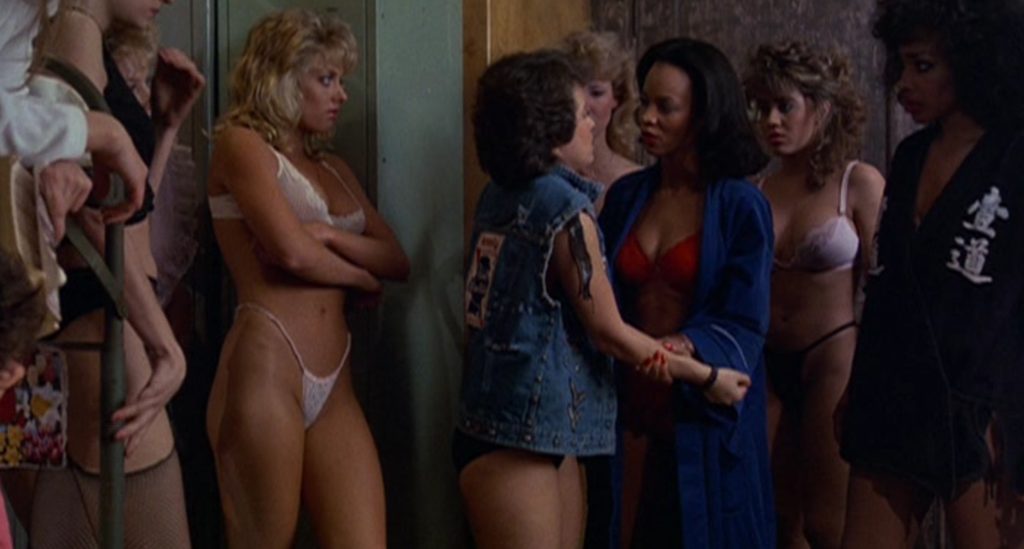
Most of the rest of the film deals with ‘life in prison’. The incidents all have one of two things in common; they involve what American Football fans describe as ‘unnecessary roughness’, or take place in the washroom – these are without doubt the CLEANEST bad girls ever. An example which comes into both categories: Charlie has taken a shine to Lisa and wants her to be one of ‘the gang’. She is initiated by being dragged into the toilets and branded with a hot wire (the video is cut at this point – at the cinema you see the burning take place, but as in “Videodrome”, the BBFC decided such things on tape might corrupt or deprave us).
Other highlights: Lisa befriends a kitten as a pet, Edna squashes it. Jenny tries to bribe a prison worker with her body, in order to escape. He quite happily accepts the bribe, then turns her in. Food fight in the mess hall, when Warden Sutter (Sybil Danning in full black gear, leather boots and a riding crop – Ms. Danning should be well up anyone’s list of discipline queens, even if they, like me, have no interest in S&M!) tries to make a speech. Some shots featuring a boom microphone. Lisa leaping off a watch tower to her death, precipitating a mini-riot. As you can see, prison life is dull and humdrum stuff.
While all this is going on, Dr. Norton is trying to complain about Edna’s ‘methods’. Sutter fires her and she goes to the press with her story. An inquiry is set up, though naturally Jemmy is not permitted to testify (she’s in the hospital following an especially unnecessary bit of roughness) and the other girls are all too scared. Heroically, however, Jenny climbs from her bed, overpowers the guard and leads a rebellion – not too difficult since there only seems to be four or five warders. Edna goes insane, climbs a watch tower while blasting away with a pump-action shotgun and is finally nailed by Charlie driving a bus into the tower, both of which then explode.
The film ends very suddenly, shortly afterwards, with Jenny being released. My guess is that the budget had given way under the pressure of buying fake silk underwear…
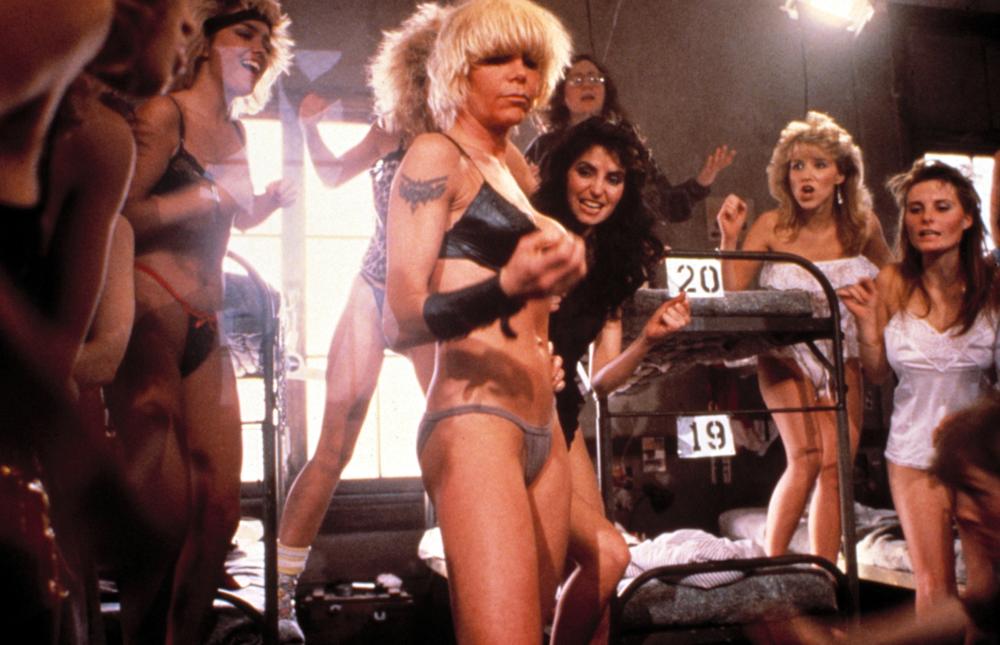
A mere synopsis isn’t enough to give the true flavour of the film. It does sound highly dodgy, but the style from start to finish is pure pantomime. The acting is completely OTT (except for Sherri Stoner, who seems to be a refugee from a SERIOUS movie), the direction is lightning fast, with some superb shots and never a moment or change for nudity wasted, and the characters are such stereotypes that you’ve got to cheer or hiss them as appropriate. The dialogue is brilliant; some examples :
- Warden Sutter to Edna: It’s time you put on your Fuck You boots & started kicking!
- Edna to Charlie: You’re just a shit-stain on the panties of life!!
- Edna: The name of the game is Control, ladies; COMPLETE Control…
- Charlie: She was a Wanker! You’re ALL wankers!!
INTELLIGENT and SUBTLE dialogue, isn’t it? Virtually every sentence seems to end with an exclamation mark (much like Trash City, really!). Throughout the film, it’s the little things hidden in the background that make it all work; a sign saying “Don’t Throw Food” which has a large splat of something on it; Sybil Danning’s heels which are SEVERE; and a Goth prisoner called Andrea Eldritch…
There is a strong element of parody throughout. Other women-in-cages films have ONE shower scene and ONE cat-fight, “Reform School Girls” scatters them about with reckless abandon every three minutes. Casting Wendy O. Williams as a teenager was an inspired move – older readers may remember her as lead singer of a punk group called The Plasmatics, who had a minor hit in 1978 or so with “Butcher Baby”. She must be nearly thirty in this film; she’s the only teenager with wrinkles I know…
If you read the video box blurb, you expect something one step above “Ilsa, She-Wolf of the SS”, which is a shame, ‘cos what you get is one of the purest examples of Bad Cinema I’ve seen. We are talking loud music. We are talking gratuitous nudity. We are talking gratuitous violence. We are talking Trash.
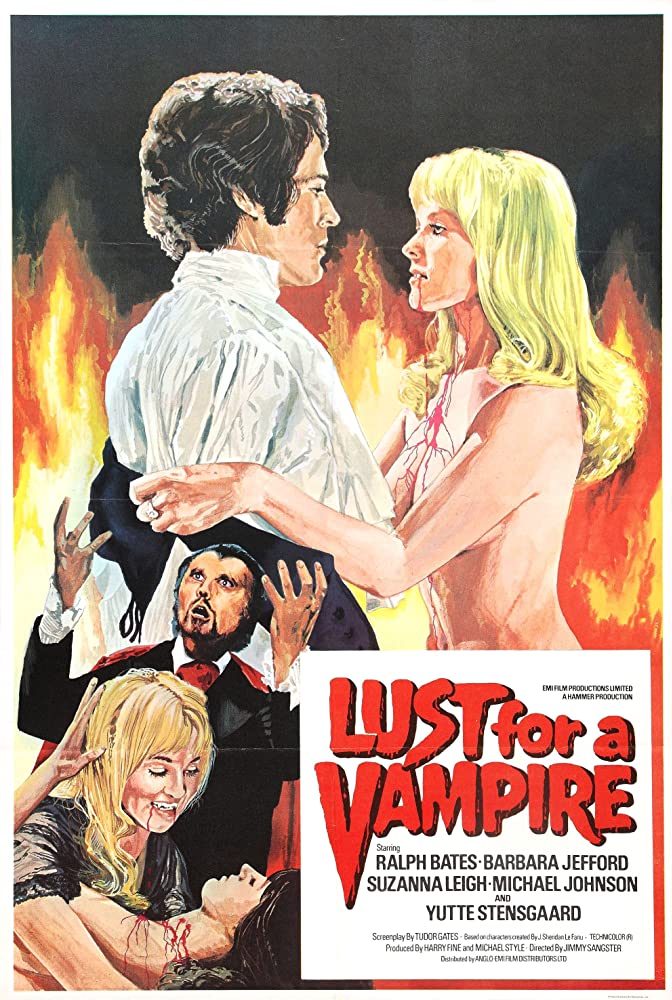
LUST FOR A VAMPIRE (Jimmy Sangster)
Yutte Stensgard, Ralph Bates, Barbara Jefford, Suzanna Leigh
Between 1957 and 1976, the Hammer film company was THE producer of horror. At least 90% of their product was excellent, but in the last few years as the competition increased, they resorted to souping up their product with sex. Sometimes this worked well (“Vampire Circus”), sometimes it didn’t. “Lust for a Vampire” was easily the tackiest product they made, gleefully sacrificing their entire vampire mythos in exchange for some soft-porn.
It all begins quite promisingly and with no hint of what was to come. A standard Hammer peasant wench wandering through the woods is picked up by a mysterious figure in a cloak and taken, screaming, to a castle where her throat is slit and her blood used to resurrect a skeleton. The first cracks show here – it’s not Christopher Lee, instead it’s some blonde bimbo.
Switch to the village inn, where Richard Lestrange, a writer of dodgy novels is staying while on a research trip. The innkeeper warns him about Castle Karnstein, home of Carmilla Karnstein and family. They’re all dead now, but this doesn’t stop them from coming out, every 40 years or so, to munch on the local virgin girls. Mr. Lestrange laughs heartily and goes up to take a look. He is surrounded by menacing hooded figures – in a plot twist unworthy of Friday the 13th, they turn out to be pupils at a nearby girls’ school out with their history teacher, Giles Barton.
They all return to said school, carefully failing to remark on the fresh blood- stains covering the altar. The other girls are having PE, which consists of dressing up in scanty Greek type gowns and waving your limbs about to the sound of a harp. [The PE mistress is called Miss Playfair!] Lestrange offers his services as an English teacher and is rejected since there’s one on the way. However, he does meet the ‘Countess Herritzen’ and her niece, Mircalla (one of the most blatant anagrams ever devised, rivalling even ‘Johnny Alucard’ for naffness).
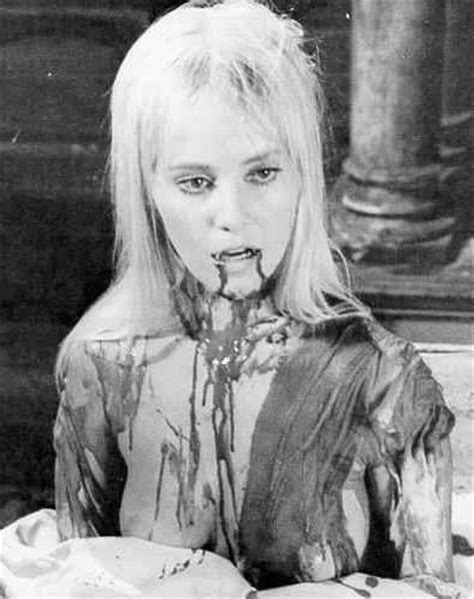
In a dormitory, where the girls are getting ready for bed (removing what little clothing they were wearing to start with), Mircalla has made friends with an American girl, Susan Perry, and gets her shoulders massaged. Her dress falls off and they arrange to go for a midnight swim.
Meanwhile, back at the inn, Lestrade meets the English teacher and tricks him into going to Vienna instead before going up to the school and taking over the post. Mircalla and Susan go for their swim (nude, naturally) and indulge in a bit of French kissing before Mircalla gets hungry… Lestrade sees her coming back and is so struck with lust he fails to ask why she’s been wandering the grounds at midnight dressed in her negligee. Susan’s disappearance is noticed, and covered up by the headmistress to prevent a scandal.
Giles Barton has discovered Mircalla’s murky past, thanks to her picture in a book, and he confronts her with the evidence (she has a lot of front to con, too). By happy chance, he turns out to be a student of Black Magic and begs to be her servant. She says “Fang you very much” [the editor wishes to disclaim absolutely any responsibility for the preceding pun] and nails him with her teeth. His body is discovered, fortunately while the Countess H. is visiting – her personal ‘physician’ certifies the death as a heart attack.
Miss Playfair reveals to Lestrade what’s been going on. While looking through Mr. Barton’s notes, he finds Mircalla’s picture – he also discovers the fang-marks on the teacher’s corpse. Undaunted, he also confronts Mircalla and shows a severe lack of originality in wanting to meet her at Castle Karnstein, in the middle of the night. They make love, even though Mircalla says it will kill him (accompanied by one of the all-time WORST movie songs – “Strange Love…” moans the singer). Guess what? For some unspecified reason, it doesn’t, and he survives with little damage apart from a couple of love-bites.
Miss Playfair plays fair and tells the police of the missing girl and dead teacher. Inspector Heinrich arrives, tells the headmistress to write to Susan’s father and has a nasty accident involving a well. Miss Playfair tells Lestrade her suspicions of Mircalla, unfortunately within the latter’s hearing; her attempted desanguination of the teacher is foiled only by the cross Miss Playfair wears. Mr Perry arrives, digs up his daughter’s coffin and finds it full of daughter, thanks to the Countess H. The fang marks are a bit of a give away, though…
In less time that it takes to say “Burn them!”, a rampaging peasant mob, led by a handy priest, has gathered, the castle is set on fire and Mircalla has the bad luck to be impaled on a burning beam that falls from the roof. Playfair and Lestrade live, we assume, happily ever after.
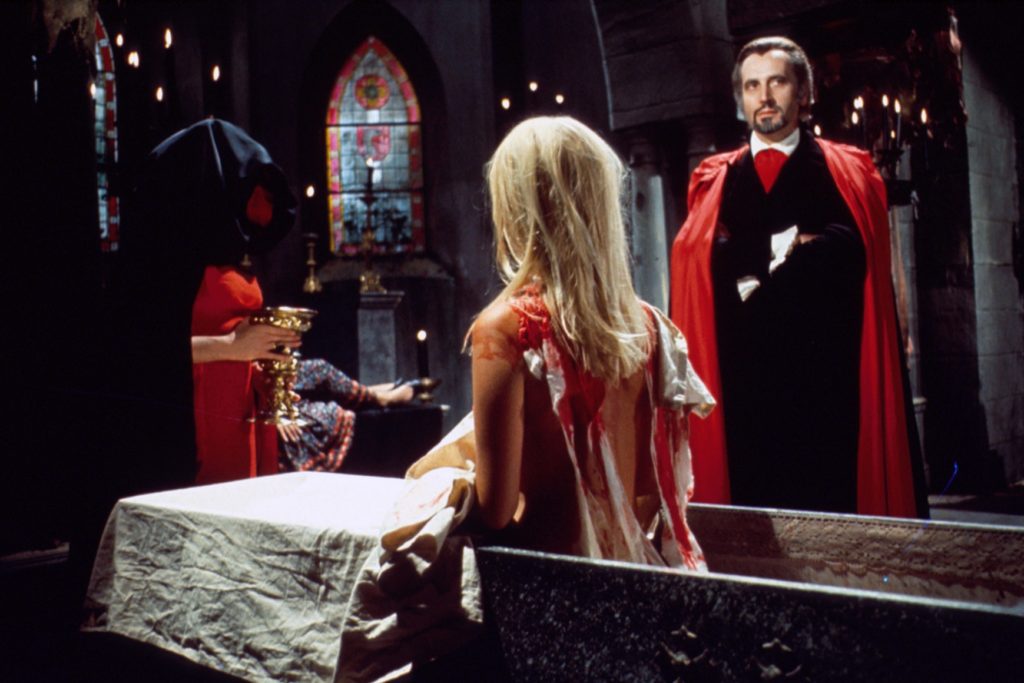
As a sexploitation film, it’s pretty good. Lots of cleavage, even if I’m sure school uniform in the 1830’s would have been more demure, plenty of blood and some great images. What makes this such an Incredibly Bad Film, then? History mainly. Forget all the things you thought you knew about vampires. Daylight? No – a schoolgirl who spends the day locked in the closet would be TOO suspicious even for this film. So daylight has no effect. What about water, as in “Dracula, Price of Darkness”? No, that’d get in the way of the swimming scene – out it goes, too. The plot is laden down with so much coincidence; luck, chance and fortune rule at every turn, enough to stretch anyone’s credibility. A perfect example: when Mr. Perry is discussing his daughter’s death in the village inn, his friend says “You don’t need a doctor, you need a…”; at that very moment, a priest arrives. Fortunate, huh? The hero isn’t your average hero either – lusting after school-girls is just not Hammer!
Hell, it’s fun. If nothing else, it’s a good reminder that even better film companies can make Bad Films – just don’t rely on it for anything other than a good time and some female flesh.
Q. What’s red and lies in the gutter?
A. A dead bus.